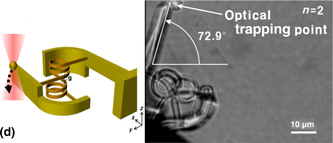Crossref Citations
This article has been cited by the following publications. This list is generated based on data provided by Crossref.
Jonušauskas, Linas
Baravykas, Tomas
Andrijec, Dovilė
Gadišauskas, Tomas
and
Purlys, Vytautas
2019.
Stitchless support-free 3D printing of free-form micromechanical structures with feature size on-demand.
Scientific Reports,
Vol. 9,
Issue. 1,
Jin, Guang-Xin
Hu, Xin-Yu
Ma, Zhuo-Chen
Li, Chun-He
Zhang, Yong-Lai
and
Sun, Hong-Bo
2019.
Femtosecond laser fabrication of 3D templates for mass production of artificial compound eyes.
Nanotechnology and Precision Engineering,
Vol. 2,
Issue. 3,
p.
110.
Jonušauskas, Linas
Mackevičiūtė, Dovilė
Kontenis, Gabrielius
and
Purlys, Vytautas
2019.
Femtosecond lasers: the ultimate tool for high-precision 3D manufacturing.
Advanced Optical Technologies,
Vol. 8,
Issue. 3-4,
p.
241.
Izard, A. G.
Garcia, E. P.
Dixon, M.
Potma, E. O.
Baldacchini, T.
and
Valdevit, L.
2020.
Enhanced adhesion in two-photon polymerization direct laser writing.
AIP Advances,
Vol. 10,
Issue. 4,
Choi, Jae-Won
Lee, Jisun
Do, HanMyeong
Kim, Young Choel
Park, Jiyong
Son, Yong
Kim, Gyeong-Ji
Lee, Kwon-Jai
An, Jeung Hee
and
Ha, Cheol-Woo
2020.
Three-dimensional Continuous Laser Scanning Method for Three-dimensional Microcell Chip Application.
Journal of the Korean Society of Manufacturing Technology Engineers,
Vol. 29,
Issue. 5,
p.
370.
Sänger, Johanna C.
Pauw, Brian R.
Sturm, Heinz
and
Günster, Jens
2020.
First time additively manufactured advanced ceramics by using two-photon polymerization for powder processing.
Open Ceramics,
Vol. 4,
Issue. ,
p.
100040.
Palmara, Gianluca
Frascella, Francesca
Roppolo, Ignazio
Chiappone, Annalisa
and
Chiadò, Alessandro
2021.
Functional 3D printing: Approaches and bioapplications.
Biosensors and Bioelectronics,
Vol. 175,
Issue. ,
p.
112849.
Zhang, Yong-Lai
Li, Ji-Chao
Zhou, Hao
Liu, Yu-Qing
Han, Dong-Dong
and
Sun, Hong-Bo
2021.
Electro-responsive actuators based on graphene.
The Innovation,
Vol. 2,
Issue. 4,
p.
100168.
Roppolo, Ignazio
Chiappone, Annalisa
Chiadò, Alessandro
Palmara, Gianluca
and
Frascella, Francesca
2022.
High Resolution Manufacturing from 2D to 3D/4D Printing.
p.
155.
Ha, Cheol Woo
2023.
Overcoming delamination in two-photon lithography for improving fabrication of 3D microstructures.
Micro and Nano Systems Letters,
Vol. 11,
Issue. 1,
Lee, Jisun
Park, Seong Jun
Han, Seung Chul
Prabhakaran, Prem
and
Ha, Cheol Woo
2023.
Enhanced mechanical property through high-yield fabrication process with double laser scanning method in two-photon lithography.
Materials & Design,
Vol. 235,
Issue. ,
p.
112389.
Ha, Cheol Woo
and
Son, Yong
2023.
Development of the multi-directional ablation process using the femtosecond laser to create a pattern on the lateral side of a 3D microstructure.
Scientific Reports,
Vol. 13,
Issue. 1,
Ha, Cheol Woo
and
Sue, Hae Jin
2025.
A new direct-laser-writing process established using creative strategies derived from several design theories.
Progress in Additive Manufacturing,
Vol. 10,
Issue. 10,
p.
8577.


